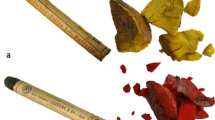Abstract
Archaeological samples are complex in composition since they generally comprise a mixture of materials submitted to deterioration factors largely dependent on the environmental conditions. Therefore, the integration of analytical tools such as TXRF, FT-IR and GC–MS can maximize the amount of information provided by the sample. Recently, two black rock art samples of camelid figures at Alero Hornillos 2, an archaeological site located near the town of Susques (Jujuy Province, Argentina), were investigated. TXRF, selected for inorganic information, showed the presence of manganese and iron among other elements, consistent with an iron and manganese oxide as the black pigment. Aiming at the detection of any residual organic compounds, the samples were extracted with a chloroform–methanol mixture and the extracts were analyzed by FT-IR, showing the presence of bands attributable to lipids. Analysis by GC–MS of the carboxylic acid methyl esters prepared from the sample extracts, indicated that the main organic constituents were saturated (C16:0 and C18:0) fatty acids in relative abundance characteristic of degraded animal fat. The presence of minor C15:0 and C17:0 fatty acids and branched-chain iso-C16:0 pointed to a ruminant animal source.

Rock art painting at Hornillos 2 Cave, Susques, Argentina






Similar content being viewed by others
References
Chalmin E, Menu M, Vignaud C (2003) Meas Sci Technol 14:1590–1597
Garate D, Laval E, Menu M (2004) Lánthropologie 108:251–289
Scott DA, Hyder WD (1993) Studin Conserv 38:155–173
Loy TH, Jones R, Nelson DE, Mehan B, Vogel J, Southon J, Cosgrove R (1990) Antiquity 64:110–116
Nelson DE, Chaloupka G, Chippindale C, Alderson MS, Southon JR (1995) Archaeometry 37:151–156
Watchman A, Cole N (1993) Antiquity 67:355–358
Spades S, Russ J (2005) Archaeometry 47:115–126
Aschero CA (1983-85) Cuad Inst Nac Antropol 10:291–306
Aschero CA, Podestá MM (1986) Runa XVI:29–57
Boschín MT, Seldes AM, Maier MS, Casamiquela RM, Ledesma R, Abad G (2002) Zephyrus 55:183–198
Vázquez C (2007) Report IAEA/AL/181:29–34
Vázquez C, Maury AM, Albornoz A, Hajduk A. (2006) Brazilian Synchrotron Light Laboratory, Activity report. In press
Maier MS, de Faria DLA, Boschín MT, Parera SD, del Castillo Bernal MF (2007) Vib Spectrosc 44:182–186
Rial GE, Barbosa CE (1983–85) Cuad Inst Nac Antropol 10:313–317
Wainwright INM, Helwig K, Rolandi DS, Gradin C, Podestá MM, Onetto M, Aschero CA (2002) Rock paintings conservation and pigment analysis at Cueva de las Manos and Cerro de los Indios, Santa Cruz (Patagonia), Argentina. In: Vontobel R (ed) 13th Triennial Meeting Rio de Janeiro, vol 2. James and James, London
Wainwright INM, Helwig K, Podestá MM, Belelli C (2000) Analysis of pigments from rock painting sites in Rio Negro and Chubut Provinces. In: Podestá MM, de Hoyos M (eds) Arte en las rocas. Arte rupestre, menhires y piedras de colores en la Argentina Sociedad Argentina de Antropología y Asociación de Amigos del Instituto Nacional de Antropología y Pensamiento Latinoamericano, Buenos Aires
Parera SD, Maier MS, Llamazares AM (2007) Identificación de 5-metoxi-N,N-dimetiltriptamina en pinturas rupestres de la provincia de Catamarca. In Rosa Erra Balsells (ed.) XVI Simposio Nacional de Química Orgánica (Sociedad Argentina de Investigación en Química Orgánica), Buenos Aires
Yacobaccio HD, Catá MP, Morales MR, Joly D, Azcune C (2007) Ocupaciones humanas tempranas en la Puna de Atacama: el Alero Hornillos 2, Susques (Jujuy). British Archaeological Reports (in press)
von Bohlen A (2004) e-Preservationscience 1:23–34
Pepe C, Clottes J, Menu M, Walter PH (1991) Acad Sci Paris 312:929–934
Regert M, Garnier N, Decavallas O, Cren-Olivé C, Rolando C (2003) Meas Sci Technol 14:1620–1630
Munsell Soil Colour Charts (1994) Macbeth, New York
Guineau B, Lorblanchet M, Gratuze B, Dulin L, Roger P, Akrich R, Muller F (2001) Archaeometry 43:211–225
Hradil H, Grygar T, Hradilová J, Bezdicka P (2003) Appl Clay Sci 22:223–36
Helwig K (2007) Iron oxide pigments. Natural and synthetic. In: Berrie BH (ed) Artists’ pigments. A handbook of their history and characteristics vol 4. Archetype, London
Nullo FE (1988) Descripción geológica de la Hoja 4 a-b Susques, Provincia de Jujuy. SEGEMAR Argentina
Turner JC, Méndez V (1979) Puna. Geología Regional Argentina. Volumen I. Academia Nacional de Ciencias, Córdoba
Coira BL (1999) Recursos Minerales de la República Argentina, SEGEMAR, Anales 35:1557–1567. Buenos Aires
Derrick MR, Stulik D, Landry JM (1999) Infrared spectroscopy in conservation science. The Getty Conservation Institute, Los Angeles
Spangenberg JE, Jacomet S, Schibler J (2006) J Archaeol Sci 33:1–13
Copley MS, Bland HA, Rose P, Horton M, Evershed RP (2005) Analyst 130:860–871
Kimpe K, Jacobs PA, Waelkens M (2001) J Chromatogr A 937:87–95
Kimpe K, Jacobs PA, Waelkens M (2002) J Chromatogr A 968:151–160
Mirabaud S, Rolando C, Regert M (2007) Anal Chem 79:6182–6192
Zhou Y, Sheng G, Fu J, Geng A, Chen J, Xiong Y, Zhang Q (2003) Chem Geol 199:343–359
Wendt CJ, Lu S-T (2006) J. Archaeol Sci 33:89–97
Maurer J, Möhring T, Rullkötter J (2002) J. Archaeol Sci 29:751–762
Bothe CI (2007) Asphalt. In: Berrie BH (ed) Artists’ pigments. A handbook of their history and characteristics, vol 4. Archetype, London
Alonso RN (2006) Ser Correl Geol 21:155–170
Acknowledgements
This research was supported by the University of Buenos Aires (Grant X314) and IAEA (contract no. 13864). M.S.M., P.S., and H.Y. are Research Members of the National Research Council of Argentina (CONICET). We thank Graciela Custo and Martha Ortiz, María Susana Alonso, and Mariana Rosenbusch for TXRF, XRD and SEM-EDX analyses, respectively.
Author information
Authors and Affiliations
Corresponding author
Rights and permissions
About this article
Cite this article
Vázquez, C., Maier, M.S., Parera, S.D. et al. Combining TXRF, FT-IR and GC–MS information for identification of inorganic and organic components in black pigments of rock art from Alero Hornillos 2 (Jujuy, Argentina). Anal Bioanal Chem 391, 1381–1387 (2008). https://doi.org/10.1007/s00216-008-2038-4
Received:
Revised:
Accepted:
Published:
Issue Date:
DOI: https://doi.org/10.1007/s00216-008-2038-4




